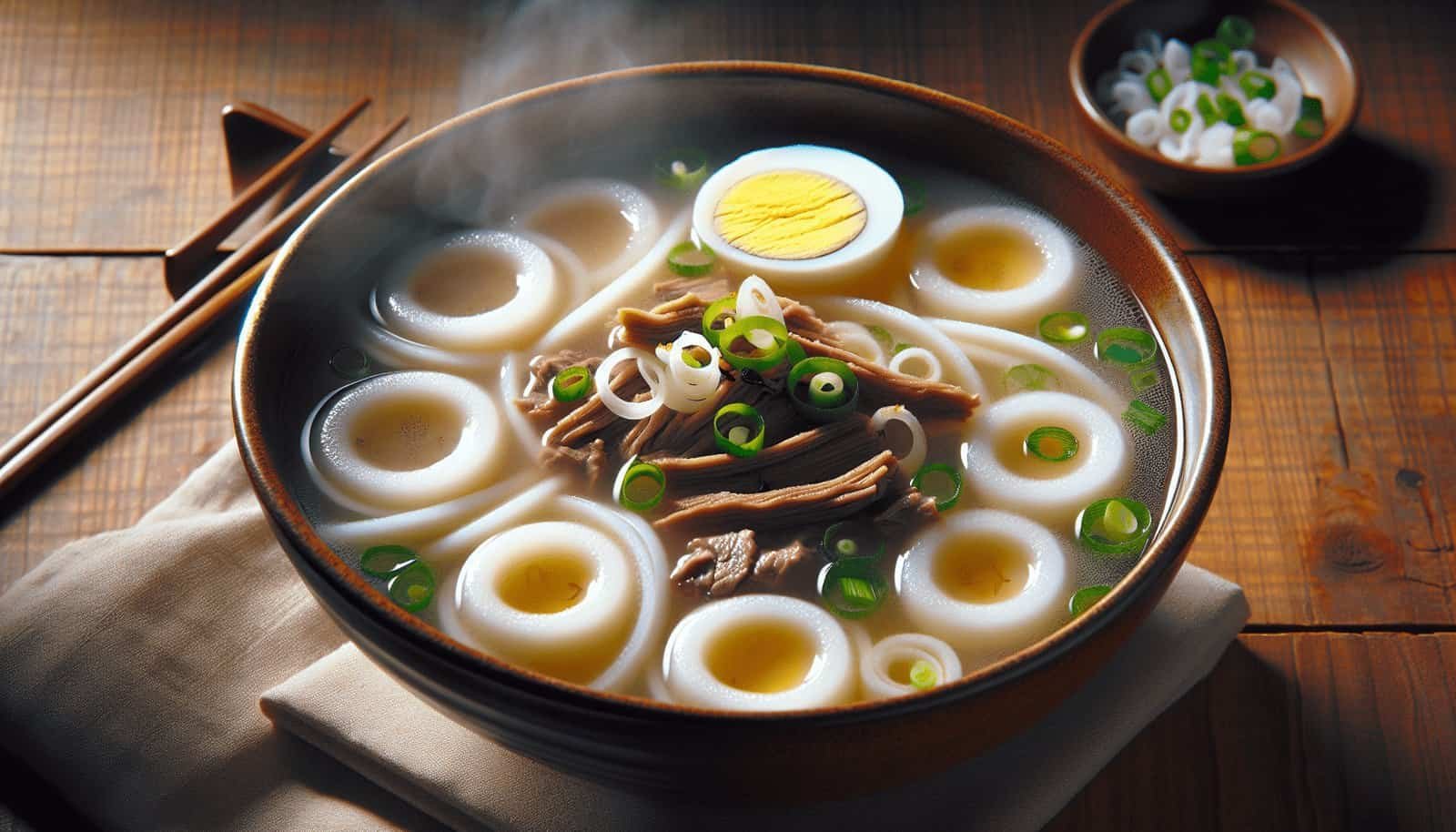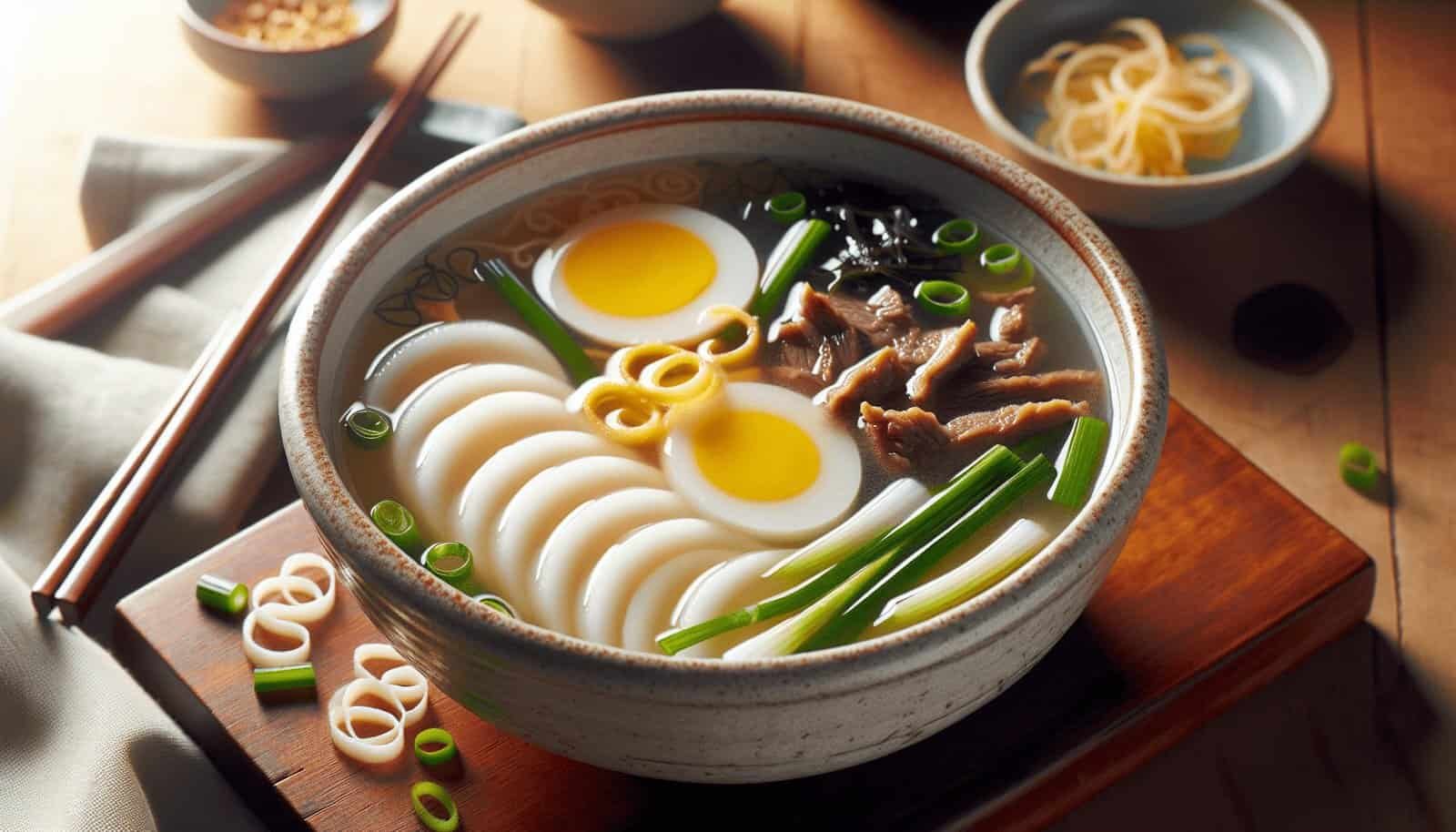Have you ever wondered how traditional Korean rice cake soup (tteokguk) is prepared and served? This beloved dish has a special place in Korean culture, particularly during festive occasions like Seollal (Korean Lunar New Year). Let’s take a journey through its ingredients, preparation methods, and traditional serving styles to get an intimate understanding of how this delicious soup is crafted.

Understanding Tteokguk
What is Tteokguk?
Tteokguk is a comforting soup made primarily of sliced rice cakes known as “tteok” that float in a clear, savory broth. It’s a quintessential dish during the Korean Lunar New Year, symbolizing growth, prosperity, and the passage into a new age.
Historical Significance
The tradition of eating tteokguk dates back centuries and carries with it cultural and symbolic meanings. Consuming a bowl of tteokguk is said to add a year to one’s age, making it a deeply symbolic act during the New Year celebrations.
Ingredients in Traditional Tteokguk
Core Ingredients
- Tteok (Rice Cakes): These rice cakes are made from glutinous rice and are typically sliced thin.
- Broth: Traditionally made from beef or anchovies, delivering a rich, savory flavor.
- Garnish: Typically includes julienned egg, seaweed, and green onions.
Optional Ingredients
- Vegetables like Korean radish (mu)
- Dumplings (mandu)
- Soy sauce for seasoning
Table of Core Ingredients
| Ingredient | Description |
|---|---|
| Tteok | Thinly sliced rice cakes |
| Broth | Made from beef or anchovies |
| Garnish | Julienned egg, seaweed, green onions |
Preparing Tteokguk
Step-by-Step Preparation
Step 1: Preparing the Tteok
First, soak the rice cakes in water for about 30 minutes to soften them. This ensures they cook evenly and maintain a chewy texture without becoming mushy.
Step 2: Making the Broth
- Beef Broth: Place marrow bones and meat in water and boil, creating a deep, rich base. Skim off any impurities that rise to the surface to maintain clarity.
- Anchovy Broth: Clean and dry anchovies and boil them with dried kelp to achieve a lighter, yet flavorful base.
Step 3: Season the Broth
Add garlic, soy sauce, and salt to the broth. Let it simmer to meld the flavors together before adding the soaked rice cakes.
Cooking the Rice Cakes
Once the broth is ready, add the soaked rice cakes. Stir occasionally to prevent sticking. The rice cakes will float to the top when they are cooked, typically taking about 5-10 minutes.
Adding Garnishes
Preparing Garnishes
- Julienned Eggs: Separate the egg yolks from the whites, cook them separately in a non-stick pan, and thinly slice them.
- Seaweed and Green Onions: Slice thinly and set aside until ready to serve.
Final Steps
After the rice cakes are cooked and tender, pour the soup into individual bowls. Top with the prepared garnishes such as egg slices, seaweed, and green onions. A dash of sesame oil or seeds can add a flavorful finish.
Traditional Serving of Tteokguk
Presentation and Rituals
In Korean culture, the presentation of food is almost as crucial as the taste itself. Tteokguk is typically served in a deep bowl to keep it warm. The garnishes not only add visual appeal but also layers of texture and flavor.
Symbolism in Serving
Eating tteokguk is not just about the food; it embodies wishes for longevity and prosperity. Sharing this meal with family and friends during the Lunar New Year enhances its significance, reinforcing bonds and welcoming the new year together.

Variations of Tteokguk
Regional Differences
Different regions in Korea may have their own twists on the dish. For example, some may add dumplings known as “mandu” to the soup, making it “tteok-mandukguk”.
Modern Twists
In recent times, variations with different types of broth, such as chicken or vegetable, have also become popular, catering to diverse palates and dietary preferences.
Table of Tteokguk Variations
| Variation | Description |
|---|---|
| Tteokguk | Traditional, beef or anchovy broth |
| Tteok-Mandukguk | Addition of dumplings |
| Chicken Tteokguk | Made with chicken broth for a lighter flavor |
| Vegetarian Tteokguk | Uses vegetable broth and omits meat-based ingredients |
Health Benefits of Tteokguk
Nutritional Value
Tteokguk is often rich in essential nutrients, depending on the ingredients used. The broth provides proteins and minerals, while the rice cakes contribute carbohydrates, making it a well-rounded meal.
Cultural Well-being
Beyond physical health, tteokguk serves to bring emotional warmth and connection, vital for mental well-being. Sharing a hearty bowl with loved ones can significantly uplift spirits.
Tips for Making Perfect Tteokguk
Choosing the Right Tteok
Fresh tteok is always preferable, as it provides the best texture and taste. If using frozen tteok, ensure it is thoroughly thawed and soaked before cooking.
Achieving the Perfect Broth
The richness of the broth is crucial for a tasty tteokguk. Take your time simmering the broth to extract the maximum flavor from either beef bones or anchovies.
Balance of Flavors
Striking a balance between savory, salty, and umami is essential. Taste and adjust the seasoning as needed during the cooking process.
Creative Garnishing
Feel free to experiment with different garnishes to add your unique touch. Classic garnishes like egg slices and seaweed are timeless, but adding colorful vegetables can bring a modern flair.
Table of Tips for Perfect Tteokguk
| Tip | Detail |
|---|---|
| Choosing the Right Tteok | Opt for fresh tteok; soak thoroughly if using frozen |
| Perfect Broth | Simmer patiently for maximum flavor |
| Balance of Flavors | Taste and adjust seasoning as needed |
| Creative Garnishing | Experiment with traditional and modern garnishes to enhance presentation |
Conclusion
Understanding how traditional Korean rice cake soup (tteokguk) is prepared and served offers a fascinating glimpse into Korean culture and culinary tradition. Each step, from selecting ingredients to cooking and serving, carries its own significance, making tteokguk much more than just a dish—it’s a celebration of heritage and community. Next time you enjoy a bowl of tteokguk, you’ll appreciate not just the flavors, but the rich history and traditions it embodies.
Whether you’re preparing it for a festive occasion or just to nourish your soul, tteokguk is a testament to the harmony of simple ingredients and complex cultural significance. Happy cooking!
